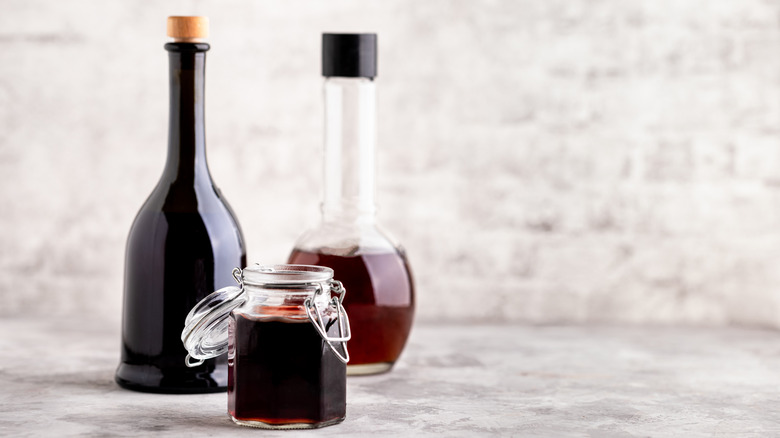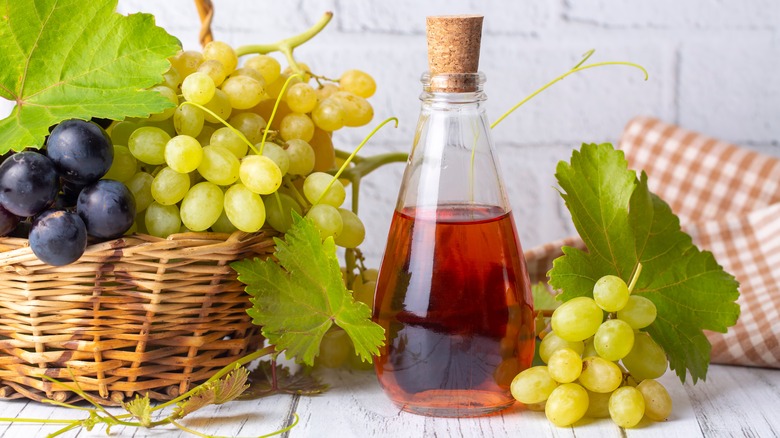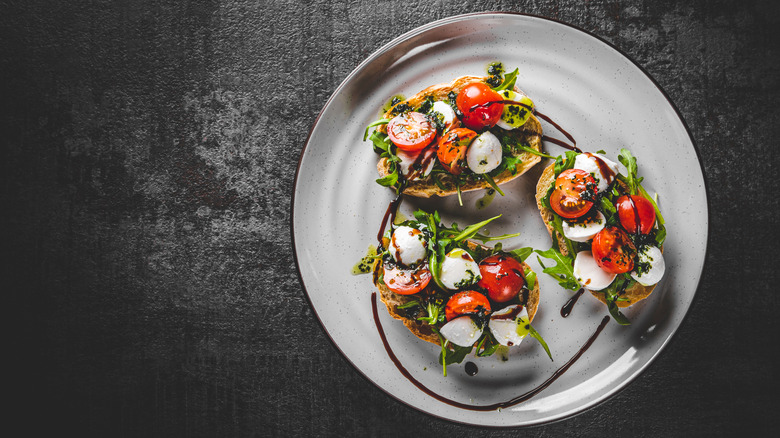Red Wine Vinegar Vs. Balsamic: What's The Difference?
Stirring up a tangy salad dressing? Or whipping up a flavorsome sauce? With so many different types of vinegar to choose from, it can be confusing to know which one to reach for.
Red wine vinegar and balsamic are classic and popular vinegars made from grapes, known for their acetic acid bite (via SPICEography). Although they can sometimes be switched out for each other, there are quite a few differences between them. You can use them interchangeably in many salads, sauces, and marinades, but they are generally suited for different uses.
Specifically, the two vinegars differ in their taste, consistency, and fermentation process. Red wine vinegar has a thin, liquidy texture, whereas balsamic tends to be thick and syrupy. Unlike red wine vinegar, balsamic makes its way straight to the vinegar stage, never becoming a wine. As a result, balsamic is the milder and sweeter vinegar. Here's a short guide to help you quickly discern between the two.
Red wine vinegar
Red wine vinegar is an extremely versatile and vibrant condiment. It can be used to brighten up a salad or punch up the flavor of your roasted vegetables. It makes a yummy addition to many different types of sauces, soups, and stews. Much like its alcoholic namesake, red wine vinegar varies in its taste, ranging from dark to bitter to fruity, explains The Spruce Eats. You can pair it with many of the same foods that you would drink red wine with, namely hearty dishes.
Red wine vinegar has a much stronger acidic kick than balsamic, according to SPICEography. Use it to whisk together a marinade, mixing in some garlic, mustard, seasoning, and vegetable oil (via Food.com).
Red wine vinegar has a much shorter aging process than balsamic vinegar. Starting off as an alcoholic beverage, it's fermented for up to two years. It's fairly straightforward to make at home, even with an inexpensive bottle of red. Simply stir together some red wine and raw live vinegar. Specifically, raw apple cider vinegar contains a "mother" culture known as Mycoderma aceti, which speeds up the fermentation of alcohol into vinegar. Cover the mixture with a cheesecloth and allow it to cultivate over a couple of weeks. Once you're able to taste and smell the vinegar, strain it into a sealed bottle.
Balsamic vinegar
If you're after something a bit more delicate, balsamic vinegar might be the right move (via Keyingredient). With its slightly-sour, slightly-sweet flavor, the condiment pairs well with various dishes, including bruschetta, goulash, and Tuscan tortellini salad. You can also use it to deglaze your pan, creating a rich sauce after you have been pan-frying or sautèing.
Although both balsamic and red wine vinegar can be turned into a glaze, balsamic is particularly well-suited for this with its taste and texture, according to SPICEography. Combine it with maple syrup to concoct a sticky-sweet glaze for your favorite roasted vegetables.
Balsamic vinegar is made out of unfermented grape juice, which is first boiled down to 30% of its volume and then aged for 12 years or more. This might explain why high-quality balsamic tends to be one of the more expensive vinegars on the market. Due to its lengthy aging process, balsamic is mild in its acidity. Over time, it develops a sweet and concentrated flavor. You can make your own balsamic vinaigrette by shaking together some olive oil, vinegar, salt and pepper, with a ratio of three parts oil and one part vinegar, per Kitchn. Spruce this up with some chopped herbs, shallots, and mustard.


